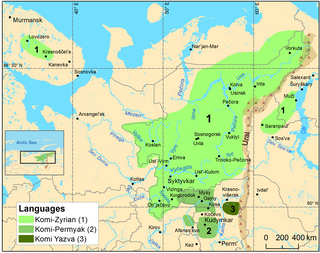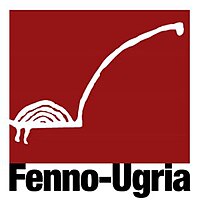
Finno-Ugric or Finno-Ugrian (Fenno-Ugrian) is a traditional grouping of all languages in the Uralic language family except the Samoyedic languages. Its formerly commonly accepted status as a subfamily of Uralic is based on criteria formulated in the 19th century and is criticized by some contemporary linguists such as Tapani Salminen and Ante Aikio as inaccurate and misleading. The three most-spoken Uralic languages, Hungarian, Finnish, and Estonian, are all included in Finno-Ugric.

The Uralic languages form a language family of 42 languages spoken predominantly in Europe and North Asia. The Uralic languages with the most native speakers are Hungarian, Finnish, and Estonian. Other languages with speakers above 100,000 are Erzya, Moksha, Mari, Udmurt and Komi spoken in the European parts of the Russian Federation. Still smaller minority languages are Sámi languages of the northern Fennoscandia; other members of the Finnic languages, ranging from Livonian in northern Latvia to Karelian in northwesternmost Russia; and the Samoyedic languages, Mansi and Khanty spoken in Western Siberia.

Ural-Altaic, Uralo-Altaic or Uraltaic is a linguistic convergence zone and abandoned language-family proposal uniting the Uralic and the Altaic languages. It is generally now agreed that even the Altaic languages do not share a common descent: the similarities among Turkic, Mongolic and Tungusic are better explained by diffusion and borrowing. Just as Altaic, internal structure of the Uralic family also has been debated since the family was first proposed. Doubts about the validity of most or all of the proposed higher-order Uralic branchings are becoming more common. The term continues to be used for the central Eurasian typological, grammatical and lexical convergence zone.

The Komi are an Indigenous Permian ethnic group whose homeland is in the northeast of European Russia around the basins of the Vychegda, Pechora and Kama rivers. They mostly reside in the Komi Republic, Perm Krai, Murmansk Oblast, Khanty–Mansi Autonomous Okrug, and Yamalo-Nenets Autonomous Okrug in the Russian Federation.

The Ugric or Ugrian languages are a proposed branch of the Uralic language family.

Komi, also known as Zyran, Zyrian or Komi-Zyryan, is one of the two regional varieties of the pluricentric Komi language, the other regional variety being Permyak.

Nenets is a pair of closely related languages spoken in northern Russia by the Nenets people. They are often treated as being two dialects of the same language, but they are very different and mutual intelligibility is low. The languages are Tundra Nenets, which has a higher number of speakers, spoken by some 30,000 to 40,000 people in an area stretching from the Kanin Peninsula to the Yenisei River, and Forest Nenets, spoken by 1,000 to 1,500 people in the area around the Agan, Pur, Lyamin and Nadym rivers.

The Finno-Samic languages are a hypothetical subgroup of the Uralic family, and are made up of 22 languages classified into either the Sami languages, which are spoken by the Sami people who inhabit the Sápmi region of northern Fennoscandia, or Finnic languages, which include the major languages Finnish and Estonian. The grouping is not universally recognized as valid.
Proto-Uralic is the unattested reconstructed language ancestral to the modern Uralic language family. The hypothetical language is thought to have been originally spoken in a small area in about 7000–2000 BCE, and expanded to give differentiated Proto-Languages. Some newer research has pushed the "Proto-Uralic homeland" east of the Ural Mountains into Western Siberia.

The Ob-Ugric languages are a commonly proposed branch of the Uralic languages, grouping together the Khanty (Ostyak) and Mansi (Vogul) languages. Both languages are split in numerous and highly divergent dialects. They, along with Hungarian, are often thought to comprise the Ugric branch of the Uralic languages, though the acceptance of Ugric is less frequent than acceptance of Ob-Ugric.
Elements of a Proto-Uralic religion can be recovered from reconstructions of the Proto-Uralic language.
Eugene Arnoľdovič Helimski was a Soviet and Russian linguist. He was a Doctor of Philosophy (1988) and Professor.
Uralic neopaganism encompasses contemporary movements which have been reviving or revitalising the ethnic religions of the various peoples who speak Uralic languages. The movement has taken place since the 1980s and 1990s, after the collapse of the Soviet Union and alongside the ethnonational and cultural reawakening of the Finnic peoples of Russia, the Estonians and the Finns. In fact, Neopagan movements in Finland and Estonia have much older roots, dating from the early 20th century.

Rogier Philip Charles Eduard Blokland is a Dutch linguist and Professor of Finno-Ugric languages at Uppsala University.

Oliver Loode is an Estonian human rights activist of the international Finno-Ugric movement and Member of United Nations Permanent Forum on Indigenous Issues (UNPFII) for the term 2014–2016.

The Finnic or Fennic peoples, sometimes simply called Finns, are the nations who speak languages traditionally classified in the Finnic language family, and which are thought to have originated in the region of the Volga River. The largest Finnic peoples by population are the Finns, the Estonians, the Mordvins (800,000), the Mari (570,000), the Udmurts (550,000), the Komis (330,000) and the Sami (100,000).

Separatism in Russia refers to bids for secession or autonomy for certain federal subjects or areas of the Russian Federation. Historically there have been many attempts to break away from the Russian Empire and the Soviet Union but modern separatism took shape in Russia after the dissolution of the Soviet Union and the annexation of Crimea. Separatism in modern Russia was at its biggest in the 1990s and early 2000s. The topic became relevant again after the 2022 Russian invasion of Ukraine. The primary causes of separatism are nationalism in the republics, economic dependency, and geographic isolation.

Pan-Finnicism, also known as Pan-Fennicism or sometimes even referred to as Finno-Ugrism or even Heimoaate is a pan-nationalist idea which advocates for the political or economic unification of the Finno-Ugric peoples. The idea is broad in its meaning and most often times it simply refers to the Finno-Ugric peoples, however on rare occasion it can be limited to only the Baltic Finnic peoples or even the wider scale Finnic peoples.
International Congress for Finno-Ugric Studies the largest scientific meeting of scientists studying the culture and languages of Finno-Ugric peoples, held every five years. The first congress was organized in 1960 in Budapest, the last congress took place in 2022 in Vienna, the next congress is planned to be held in Tartu, Estonia in 2025.
















